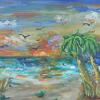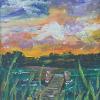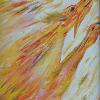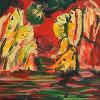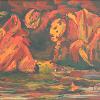New in 2022
New in 2021
New in 2019
New in 2018
2015/16
PISMO BEACH-- ACRYLIC 18W X 24H
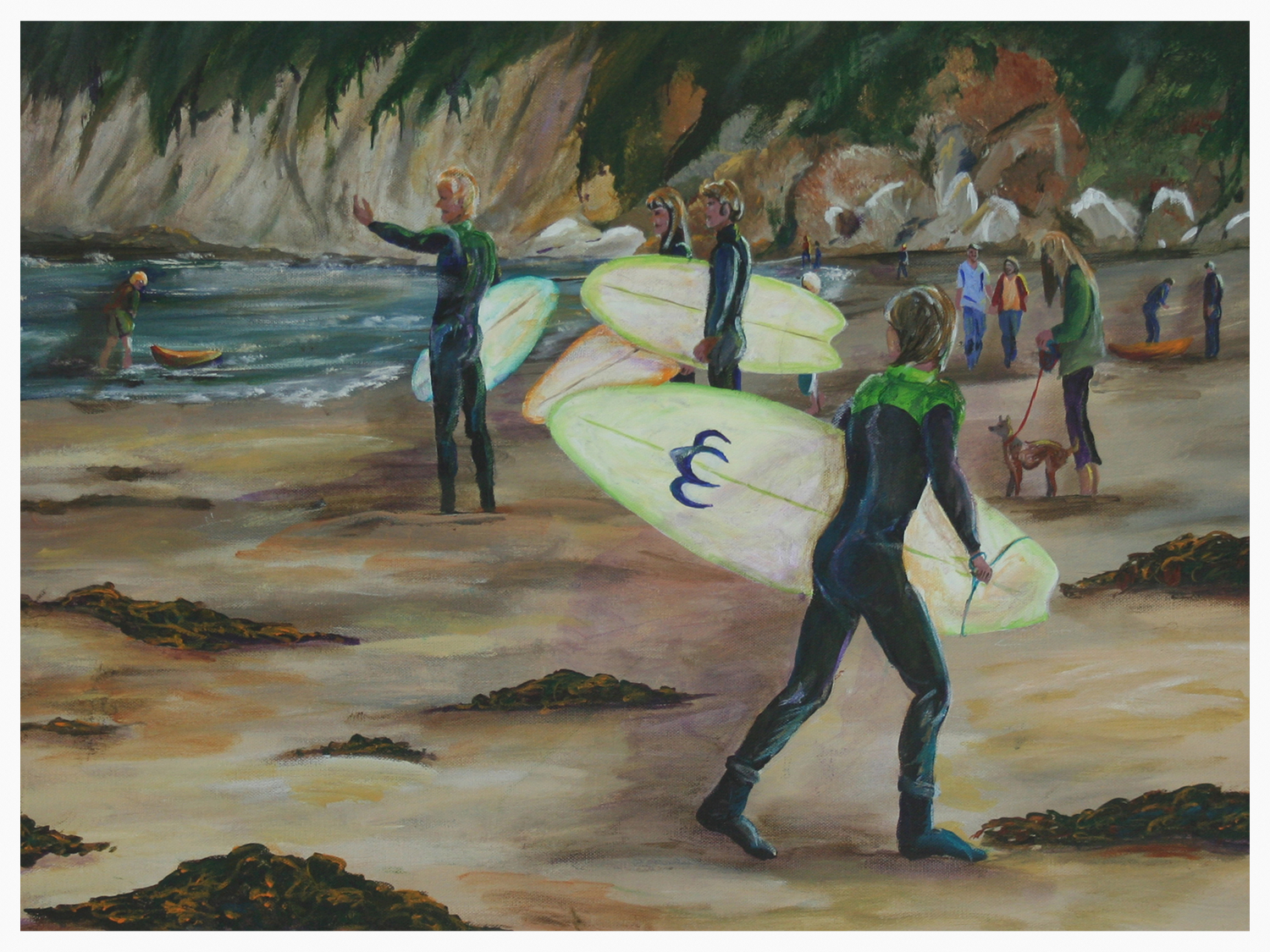 Early
morning on Pismo Beach brings out the surfers with their colorful boards. They
protect themselves from the icy Pacific Ocean with wet suits. As far as I can
remember, the locals living in the area around Oceano, Grover City and Pismo
have always enjoyed surfing. Usually there is enough wave action along this
area of the coast to provide a good time for the casual surfer. The Beach
Blanket movies starring Annette Funicello and Frankie Avalon were immensely
popular in the early 60’s decade. I remember tagging along with my best friend
when her oldest brother was forced by their mother to take us along with him
and his friends as they surfed. I don’t know how good they were; my friend and
I were about eight and we spent our time there getting sunburned and playing
near the shore.
Early
morning on Pismo Beach brings out the surfers with their colorful boards. They
protect themselves from the icy Pacific Ocean with wet suits. As far as I can
remember, the locals living in the area around Oceano, Grover City and Pismo
have always enjoyed surfing. Usually there is enough wave action along this
area of the coast to provide a good time for the casual surfer. The Beach
Blanket movies starring Annette Funicello and Frankie Avalon were immensely
popular in the early 60’s decade. I remember tagging along with my best friend
when her oldest brother was forced by their mother to take us along with him
and his friends as they surfed. I don’t know how good they were; my friend and
I were about eight and we spent our time there getting sunburned and playing
near the shore.
Despite the early hour Pismo beach usually has plenty of visitors, Families are setting up shade canopies for the day, couples are enjoying a morning walk, and children are already braving the cold water to splash in the waves. Pismo is a ‘doggy” town. There are always plenty of canine citizens being taken for walks along the beaches by their human friends. As a child, I spent a lot of time playing in the water either while my father surf fished or dug or clams. Since both of these things are not allowed near the touristy area off the Pier, we usually did our thing further down the shore where overhead casting from fishing lines couldn’t endanger beachcombers walking on the shore. The Pismo Clam of course is now on the forbidden list. A great deal of this can be attributed to the fact that the clam is a favorite food of sea otters, which are now on the protected list (in case you didn’t know putting a species on this list sometimes also includes the food they eat). When I was a child, there was also an outbreak of domoic acid poisoning, also known as amnesic shellfish poisoning in the local clam population, which led to the banning of harvesting not only the Pismo Clam but the local razor clams as well.
The history of people at Pismo Beach starts at least 9,000 years ago with the Chumash Indians, who referred to the area as a place to find pismu, or tar. The Pismo Beach region has an interesting history going back in time to 1769, when Don Gaspar de Portola and parties camped in the area. According to the diary of Costanso, a member of the Portola party, "The party continued over the sand dunes and then descended to the beach, along which they walked for several miles before camping for the night. Near their camping place was an Indian village of some forty people." Undoubtedly, the beach walked upon by the Portola party was that known today as Pismo Beach. The 1900s were wild times in Pismo Beach. Pismo was noted for having many saloons, along with several notorious brothels. Besides the hotels, 0ther amusement type businesses offered a variety of entertainment, including a skating rink, a bowling alley, and a dance hall. The property directly south of Shell Beach now known as Dinosaur Caves, was the site of an amusement park, with a giant cement dinosaur to gather attention. H. Douglas Brown started building the dinosaur in 1948 and was stopped by local opposition. The headless dinosaur remained a local landmark until it was torn down in the late 1950s. Pismo Beach was also known as a place to find booze during the Prohibition Era.
SAFE HARBOR-- ACRYLIC 18W X 24H
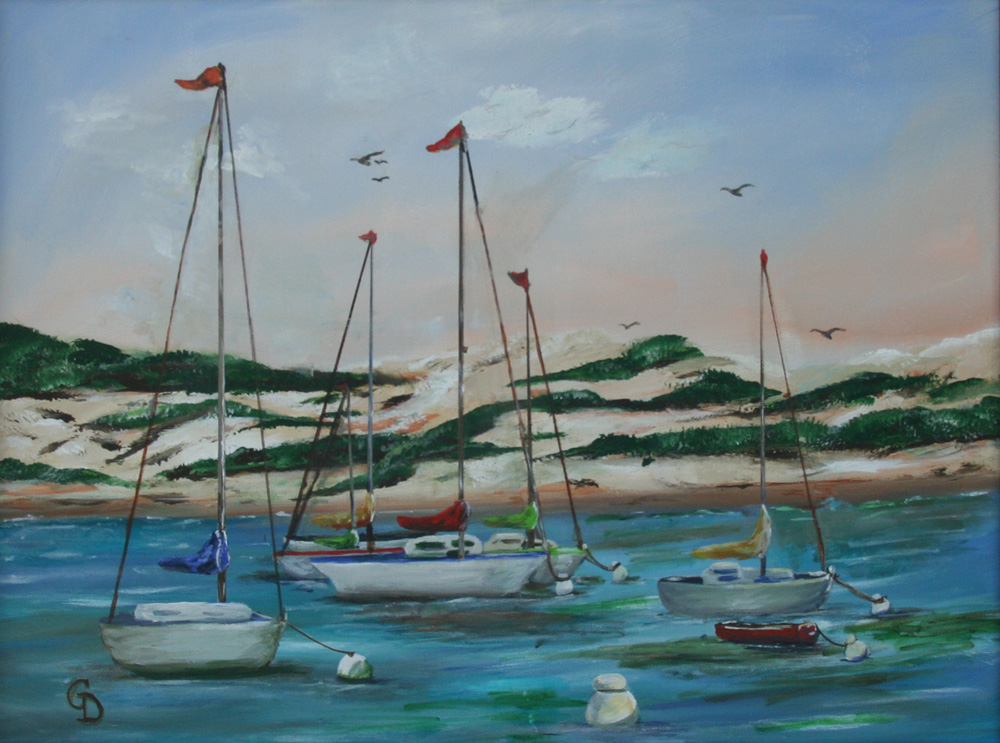
I have always found boats and ships fascinating. I took the photo for this painting when my husband and I attended the annual Pool Industry Expo (PIE) show some years ago. When I was a child, we lived in the Pismo area and I spend many days with my father on the Pismo Pier or on the shore. I have always loved watching the boats move in and out. Monterey Bay has a long history of being a safe haven for ships. As early as 1602, ships carrying elegant goods from the Manilla islands used the harbor. In 1870, a commercial wharf was built for regular passenger and freight service. Around 1913, commercial fishing industries began using it. It is now the largest marine sanctuary in the world and provides access to a variety of recreational activities.
A private or public Marina however is very different from a commercial Port, although both are usually located in a harbor. Harbors are bodies of water where ships, boats and barges can seek shelter from stormy weather, or are stored for future use. Natural harbors are usually found in bays, estuaries, and river mouths. A good harbor occurs where land and water come together and protect ships from wind and waves as they enter and dock. Harbors can also be built from jetties and causeways as well. Harbors can be natural or artificial. An artificial harbor usually has intentionally fashioned breakwaters, sea walls, or jetties, or they can be made by dredging.
Harbors include entry channels and inner channels (to allow movement to areas and support features for refueling and repair. Harbors can be found on the coast or on inland lakes. A natural harbor occurs where a part of a body of water is protected and deep enough to anchor a ship. Natural harbors are of immense tactical and financial significance. Many of the world’s great cities began on natural harbors.
Harbors and Ports are often mixed up with each other. A port is a facility for loading and unloading boats and ships. While ports are often found in harbors not every harbor has a port. A port is a manufactured coastal or lake or river area where boats and ships load and unload passengers and cargo. It may contain quays, wharfs, jetties, piers, and slipways with cranes or ramps. A port usually has buildings or warehouses for storing goods and a transportation system to move those goods inland or out to other countries. Ports are a place where rail, truck, barge, ship, and other transport methods meet.
A Marina is a dock or basin with moorings and supplies for yachts and small boats. A marina contrasts from a port because a marina usually doesn’t handle large passenger ships or cargo from freighters although many small (the word is relative) boats do take passengers out for local tours or fishing trips. The word marina is also used for inland wharves on rivers and canals used exclusively by non-industrial pleasure craft. In a Marina, Boats are generally moored on buoys, or fixed or floating walkways tied to an anchoring piling (floating docks and pontoons). Buoys are cheaper to rent but less convenient than docks allowing an owner to walk from land to boat. Harbor shuttles and water taxis may shuttle people between the shore and boats moored on buoys. Marinas may be owned and operated by a private club, such as a, but also as private enterprises or municipal facilities.
ALONG THE BOZEMAN TRAIL-- ACRYLIC 18W X 24H

I’ve always loved the western genre and when I decided that my 2016 entries in the Old West Art show would be about trail herds, I started researching their history. After the Civil War, untended herds in Texas multiplied quickly as Union blockades cut the state off from market outlets. Four-dollar-per-head cattle in Texas could bring $40 to $50 apiece in eastern markets. The Bozeman Trail was an overland route connecting the gold rush territory of Montana to the Oregon Trail. The overland Bozeman Trail followed many north-south trails used by Shoshone, Arapaho, and Lakota nations since prehistoric times to travel through Powder River Country. The Bozeman Trails most important time was from 1863-1868. It was more direct and had better access to water than other trails into Montana. Bozeman and Jacobs's most significant role was to develop the trail so that it was wide enough for wagons. But the route had a major drawback — it passed directly through territory occupied by the Shoshone, Arapaho, and Lakota nations who were tired of the flow of settlers through their territory. Since many of these travelers showed little respect for the rights of the Native Americans, the movement triggered their antipathy and caused violence. The U.S. Army embarked on several military campaigns against the Indians to try to control the trail. Because of its link with frontier history and conflict with American Indians, some sections of the trail are listed on the National Register of Historic Places
ON THE CHISHOLM TRAIL-- ACRYLIC 18W X 24H
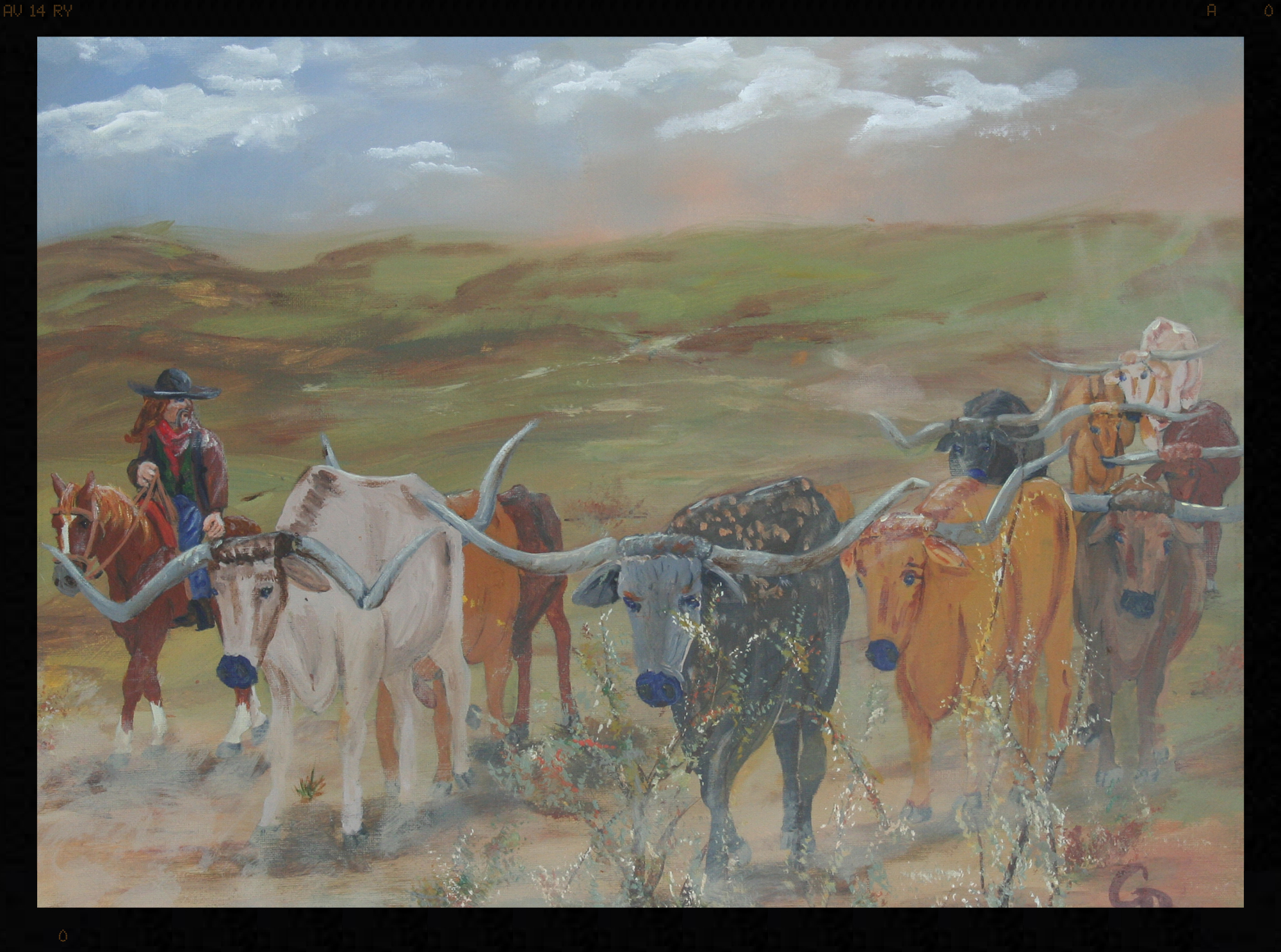
I’ve always loved the western genre and when I decided that my 2016 entries in the Old West Art show would be about trail herds, I started researching. After the Civil War, untended herds in Texas multiplied quickly as Union blockades cut the state off from market outlets. four-dollar-per-head cattle in Texas could bring $40 to $50 apiece in eastern markets In 1866 Charles Goodnight and Oliver Loving blazed the first trail, known as the Goodnight-Loving trail northwest from Palo Pinto County, Texas, to Pope's Crossing in southeastern New Mexico, and on north to Fort Sumner and Fort Bascom. In 1867 the 600-mile Chisholm Trail (sometimes referred to as Chisium) initially developed by merchant Jesse Chisholm became the main trail, and it was used extensively until 1871. It ran north from San Antonio to Fort Worth, Texas, through Oklahoma and ended at Abilene, Kansas. stock pens built in Abilene to hold cattle for shipment on the Kansas Pacific Railroad waited for the herds. In 1871 alone, Cowboys drove some 600,000-700,000 Texas Longhorns north from Texas. In 1884, the great era of the cattle trails ended when Kansas enacted a quarantine against Texas cattle due to the spread of “Texas Fever” (a tick borne cattle disease to which the longhorns were immune) effectively killing the large northern drives. The final blow to the cattle drives came when the railroads pushed trunk lines south so that cattle could be shipped directly from Texas. Sporadic drives continued on a lower basis for another decade, but the great era of the cattle trails had ended.
HOME ON THE RANGE-- ACRYLIC 18W X 24H
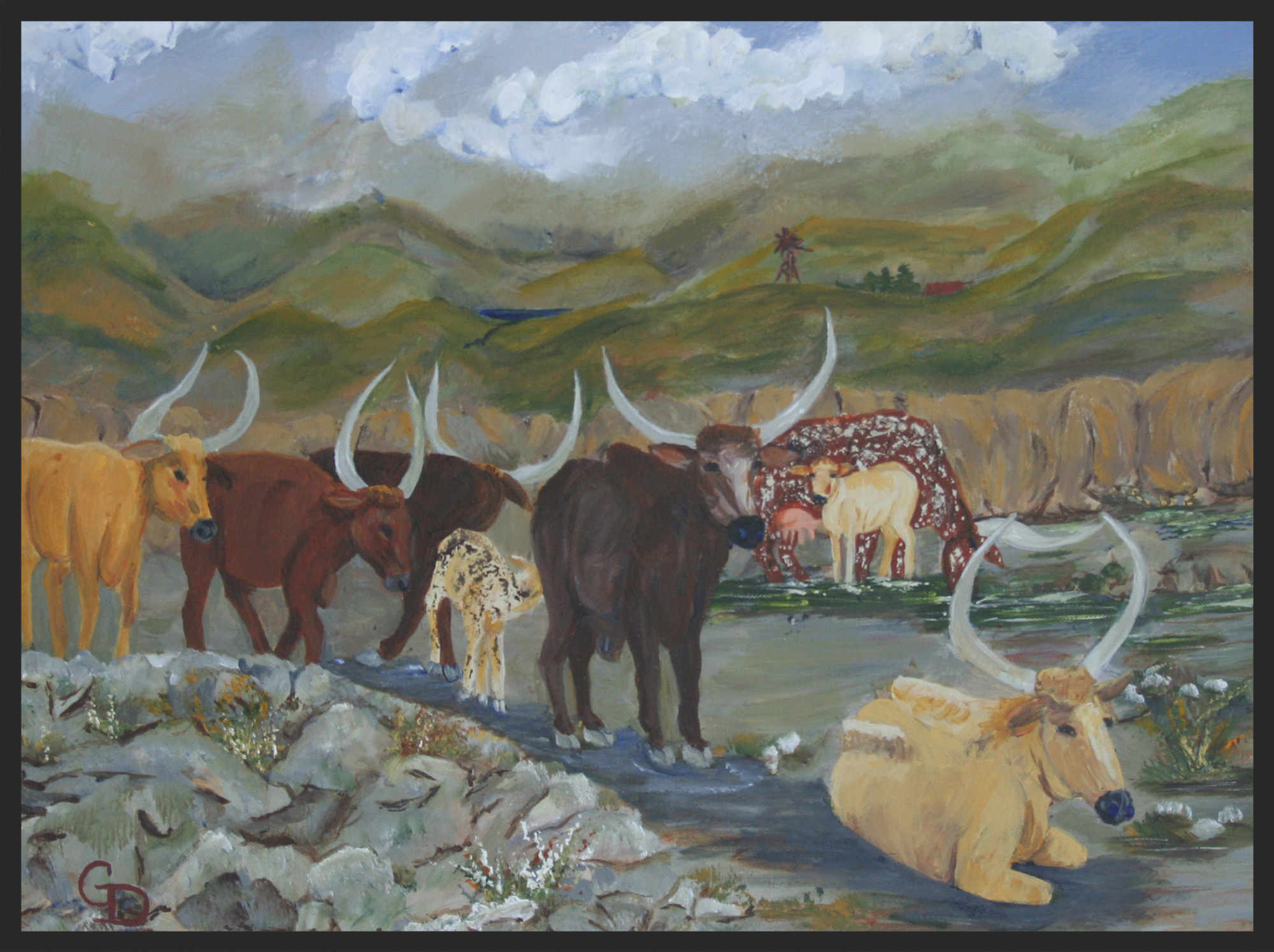
Longhorn cattle have been a part of the history of North America since 1493 when Spanish settlers brought the first few long-horned Iberian cattle with them to the Antilles Islands. Between 1493 and the mid-19th century, feral longhorns flourished in the Americas. During that period, they used natural selection to develop the qualities Longhorn Cattle are known by today, i.e. hardiness, disease resistance, ease of calving and strong mothering instincts. Longhorns can survive in harsh environments, can walk miles to water, can breed easily, and could eat almost any type of vegetation. They thrived in the wild, growing heavy-boned, skinny and swift. Their long legs and long horns provided offensive weapons and defensive protection. They also developed a fiery temper and a malicious cleverness. Beginning in about 1519, many of those cattle were brought by settlers when they traveled to Mexico in search of gold. The first known cattle in Texas arrived in the early 1700s with Franciscan missionaries as they began to build a chain of missions extending through the San Antonio River valley and out to the present city of Goliad. Little, however, is known about them in the next century other than they roamed freely on the large ranchos and mission lands in California and Texas. Since their arrival had preceded the establishment of barbed wire fencing, their range also spread well beyond these unsecured limits. It has been estimated that by 1860 about 4 million to 6 million wild long-horned cattle could be found in Texas alone.
CAT NAPPING-- ACRYLIC 18W X 24H
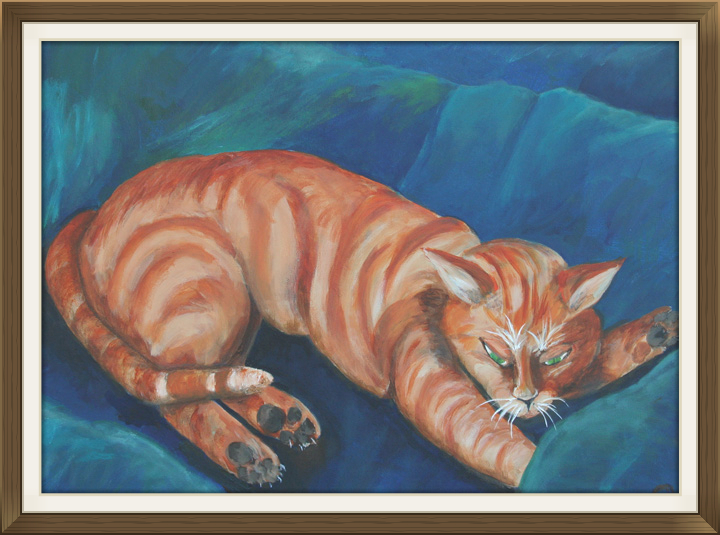
I took the photograph this painting was based on in 2015. This will be the 3rd painting I have done of Shere Khan. The first, Domestic Tiger, I did in the first three years he came to live with us. The second, Eye To Eye, I did when he was around six. We recently figured out how long he has been with us and it is about nine years. In a cat’s years that would make him approximately 75 if he were a human, so in all likelihood, this will be the last painting I do of him before he too passes over the rainbow bridge. Shere Khan was sort of a rescue. He was part of a gang of feral cats who were being fed by a woman renting an apartment where my husband serviced the apartment pool. She told my husband that his people had simply moved off and left him, a vulnerable kitten on his own. Humans can be very cruel and unthinking. At the time my husband found him, he had been wild about three months. He was only six months old so he had still been a baby when they abandoned him to fend for himself. Vernon persuaded Shere Khan to allow him to pet him and then brought him home to our mixed household of cats, dogs and a Guinea pig. He soon learned that inside our house was neutral territory and he was safe there from the dogs, but he had been wild long enough not to be happy spending all his time inside the house. He also had to learn that he wasn’t allowed to hunt or terrorize the Guinea Pig, Frosty, a big step for a kitten who had been hunting to stay alive. Since he is getting older now, he spends most of his day asleep in the yard instead of patrolling the neighborhood. He has regained control of the back yard and garage now that our four dogs have traveled over the rainbow bridge and succeeded in ridding both places of the field rats and mice that infested them. He has outlived the dogs and the Guinea pig, and has been an indulgent Uncle to two kittens. One of them Spooky passed away early from a brain tumor, but Moonstone our little princess is very much in evidence. Since feral cats in the wild have a lifespan of about five to six years, we justify ‘catnapping’ him from his feral family and adopting him. With us, he has enjoyed a more comfortable, longer life and has always had food and shelter when he needed it.
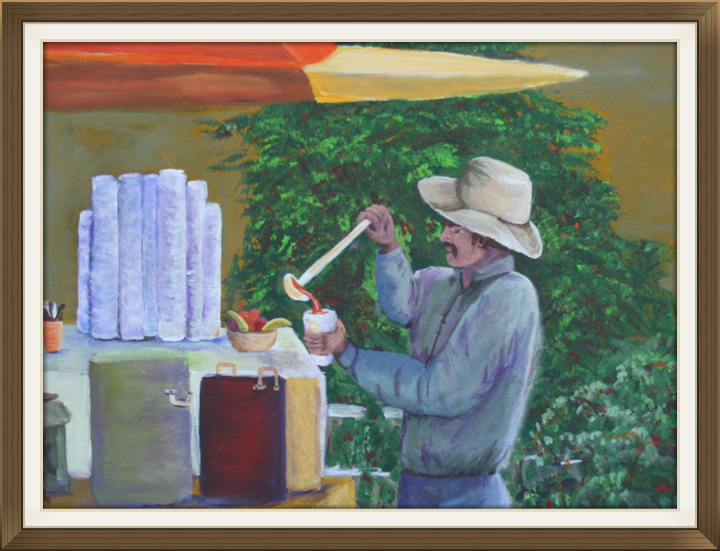
STREET VENDOR-- ACRYLIC 18W X 24H
Street Vendors such as the one in this painting have a long and varied history. A street vendor is broadly defined as a person who offers goods for sale to the public at large without having a permanent built up structure from which to sell. Street vendors have been in existence since ancient times. In all civilizations, ancient and medieval, one reads accounts of travelling merchants who not only sold their wares in the town by going from house to house but they also traded in neighboring countries. Ancient and medieval civilizations were accepting to these wandering traders and that is why they flourished. In modern times, we find that street vendors are rarely treated with the same measure of dignity and acceptance. Every city in the U.S. has its quota of these independent enterprising vendors. In New York City alone, there are more than 10,000 street vendors— hot dog vendors, flower vendors, book vendors, street artists, and many others. They are small businesspeople fighting to make ends meet. Most are immigrants and people of color. They work long hours under harsh conditions, asking for nothing more than a chance to sell their goods on the public sidewalk. They have no health insurance unless they buy it themselves, no sick leave and no unemployment insurance. The 2008 recession squeezed customer’s wallets and forced many who had previously worked a nine to five out of work and out of resources, leading to a modern street-vending boom. I took the photo for this painting one spring when I was down on Fresno’s Fulton Mall. I sometimes keep a photo for decades before I decide to use it in a painting.
APERITIF & APPETIZER INGREDIENTS-- ACRYLIC 18W X 24H
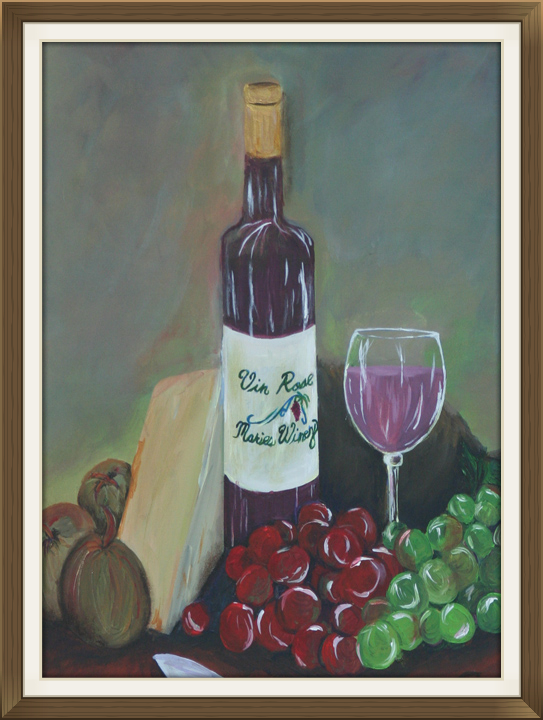 Well, here I am again attempting another
still life. I paint more for myself than for others and I am determined to conquer
this type of painting. Why is it that a still life done by my friends and
fellow artists always seems to me to breathe life and energy while my own does
not? I suppose it is true that we are our own worst critics. A painting has to
speak to me while I am working or it seems to have no magic. This one talked but I confess it kept urging
me to put a fly on the grapes or the cheese. Sometimes I do have an
inconvenient sense of humor….
Well, here I am again attempting another
still life. I paint more for myself than for others and I am determined to conquer
this type of painting. Why is it that a still life done by my friends and
fellow artists always seems to me to breathe life and energy while my own does
not? I suppose it is true that we are our own worst critics. A painting has to
speak to me while I am working or it seems to have no magic. This one talked but I confess it kept urging
me to put a fly on the grapes or the cheese. Sometimes I do have an
inconvenient sense of humor….
Aperitif (actually spelled apéritif Pronunciation: ah-pair-ee-TEEF) is a French word for a starter drink that opens a meal. More than just an opener, it is a welcome to your guests and an appetite stimulant. First of all, what is an apéritif? An aperitif is generally an alcoholic drink that precedes a large meal. Think of it as something like a beverage appetizer or hors d'oeuvre. Occasionally the term apéritif is used to describe the whole intro course that opens up your guest's palate before a large meal to follow. This usually consists of a beverage served with finger foods or "amuse buche" such as olives, bruschetta or other simple appetizers. An apéritif is a cocktail or other alcoholic beverage that is specifically served before a meal, or with a small appetizer. In the culinary arts, the purpose of an apéritif is to stimulate or arouse the appetite.
RED ROCK CROSSING -- ACRYLIC 18H X 24W
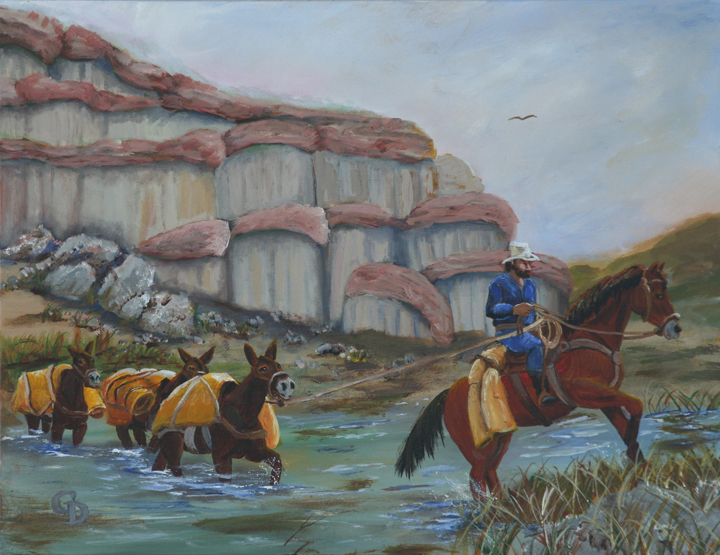 Our gold-panning group, CVPA, often holds
a group affair out at some of the more distant claims, sometimes utilizing
sites owned by sister organizations. The Camp at Duesenberg was one of these.
On the way there, we stopped so I could take some photographs of some striking
red cliffs. I used a portion of these cliffs for the background of this
painting of my imaginary traveler. I often laugh at Western movies because they
usually show their heroes setting out on long trips with nothing but their
horse. In fact, even a single traveler required enough gear to load up a pack
mule to survive on a trip. You need food for yourself and your animals, camping
gear, cooking utensils and if you were traveling in the desert, water! So I
chose to portray my traveler with all of these things.
Our gold-panning group, CVPA, often holds
a group affair out at some of the more distant claims, sometimes utilizing
sites owned by sister organizations. The Camp at Duesenberg was one of these.
On the way there, we stopped so I could take some photographs of some striking
red cliffs. I used a portion of these cliffs for the background of this
painting of my imaginary traveler. I often laugh at Western movies because they
usually show their heroes setting out on long trips with nothing but their
horse. In fact, even a single traveler required enough gear to load up a pack
mule to survive on a trip. You need food for yourself and your animals, camping
gear, cooking utensils and if you were traveling in the desert, water! So I
chose to portray my traveler with all of these things.
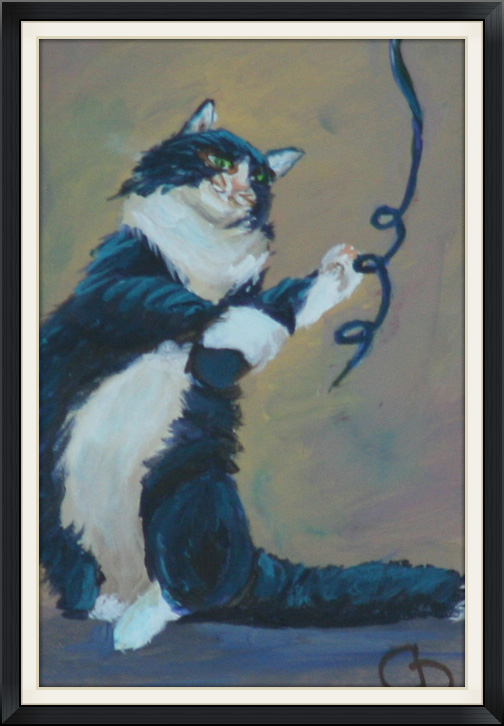 This painting is of a longhaired black
and white cat playing with a string. Cats love to chase things and they can
derive more enjoyment out of a simple ribbon dangled in front of them than all
the expensive pet toys you can buy. My friend Betsy sent this photo me when she
learned I was working on learning to paint cats. Words of Wisdom: When looking
for source material, don't underestimate the power of checking out your friends
and family!
This painting is of a longhaired black
and white cat playing with a string. Cats love to chase things and they can
derive more enjoyment out of a simple ribbon dangled in front of them than all
the expensive pet toys you can buy. My friend Betsy sent this photo me when she
learned I was working on learning to paint cats. Words of Wisdom: When looking
for source material, don't underestimate the power of checking out your friends
and family!
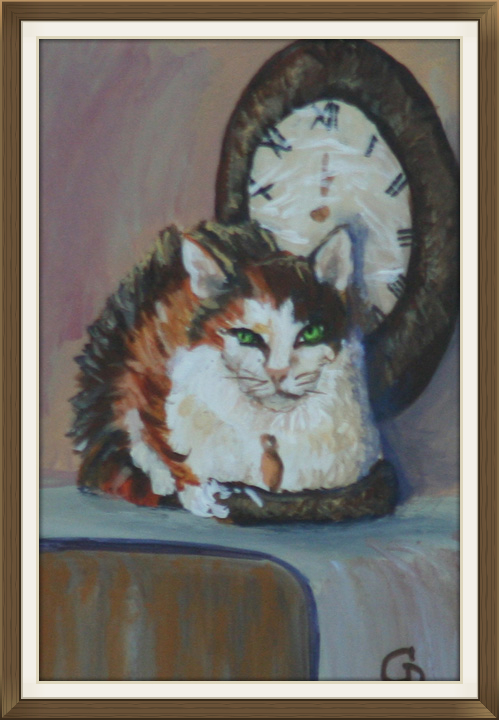 Her
name was Pixie and she chose
to
live with us. Originally she lived next door, but after an unfortunate set-to
with the dog that also lived there, she left home. Pixie began to come to our
front door asking for food, so I fed her.
Eventually she came to live with us and spent many hours in Vern’s lap,
lowering his blood pressure with her warm, soft fur and purring. Pixie spent
most of her time with us up off the floor, and she loved to be on top of the
entertainment center and bookcases. I suppose this was because she felt safe
from our dogs and from my son’s cats. She was Queen of all she surveyed.
Her
name was Pixie and she chose
to
live with us. Originally she lived next door, but after an unfortunate set-to
with the dog that also lived there, she left home. Pixie began to come to our
front door asking for food, so I fed her.
Eventually she came to live with us and spent many hours in Vern’s lap,
lowering his blood pressure with her warm, soft fur and purring. Pixie spent
most of her time with us up off the floor, and she loved to be on top of the
entertainment center and bookcases. I suppose this was because she felt safe
from our dogs and from my son’s cats. She was Queen of all she surveyed.

